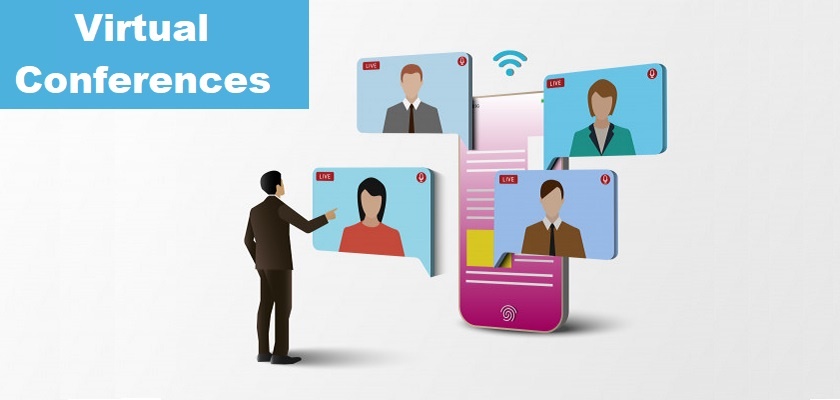With the advent of the novel coronavirus global pandemic, the event industry has experienced a major impact. Event planners and digital marketers were left in a tough position in the whole of 2020. The sudden outbreak resulted in the cancellation of various events planned for the year across the globe. It has resulted in a financial loss for many businesses worldwide.
But as we say the show must go on, and COVID-19 can’t stop the same. With the latest advancements in technology, live virtual events come to aid. Virtual events have been prevalent for a long time, but a sudden spike has been witnessed recently. It has prevented many businesses from dipping down during the time of the global crisis.
Moving ahead with the changing times, virtual video conferencing has become an integral part of almost every industry. Ever since the lockdown restrictions were imposed, organizations are leveraging technology. Large-scale and small-scale companies are webcasting for conferences to connect with a remote workforce, global delegates, customers, and so on.
Even after the lockdown restrictions have been uplifted, restriction on public gathering and traveling still implies to ensure health safety. As virtual has become the new normal and people started moving out, remote video conferencing has become the most convenient way to connect and network globally.
Today, the internet is piled up with a variety of virtual event platforms that offer interactive and engaging features. Selecting the best virtual conference platform out of all depends upon your business needs and requirements.
Some organizations that are widespread across the globe are leveraging remote video conferencing even before coronavirus came in the frame. With the change in scenario, organizations that never thought about moving their conference online are leveraging virtual video conferencing technology.
If you are new to hosting a virtual conference, this article is of your use. Virtual conferencing is a great way to connect and network with people around the globe seamlessly. In this blog post, we have enumerated the steps to set up a virtual conference in 2020 and beyond. To know how to set up a virtual conference, scroll down and get started!
Firstly, you must know what virtual conferences are for better clarity!
Highlights of Contents
What is Virtual Conferencing?

An event that is organized over the internet on a virtual conference platform instead of a physical location and enables a group of people to connect and network seamlessly is known as virtual conferencing. Same to physical conferences, virtual video conferences involve a group of people to discuss a particular subject matter. It includes AGMs, recurring meetings, webinars, trade & job fairs, etc. hosted on an interactive platform that enables virtual conference calls for free-flowing conversations in real-time.
Any event that is organized online and involves more than two people to discuss something, such events come under virtual conferencing. A virtual conferencing platform enables attendees to have one-on-one or group interactions via live audio/video/ text chats in real-time. It helps in delivering immersive event experiences to attendees.
Virtual conferencing comes with ample merits that are far beyond the reach of physical four-wall conferencing. With increased reach, attendance, and participation it has become the first choice of digital marketers and event planners. Remote video conferencing can be accessed by the participants from any corner of the world, thus overcoming the geographical barriers. Apart from geographical constraints, space limitations, traveling expenses, hiring staff, accommodation costs, etc. all get resolved with virtual conferences. Greater ROI, eco-friendly nature, data tracking, and generating more leads and revenues are the other advantages of virtual conferencing.
There you are, from your favorite device supported with an internet connection from the comfort of your own space, connect seamlessly via virtual conferencing.
10 Tips to Host a Successful Virtual Conference Event

All you need to do is the same thing you do while planning a physical conference. With the same planning, but with the technology. A little creativity, right virtual event strategy, and planning results in superb execution of virtual video conferencing. New to webcasting for conferences and do not know where to start? Well, we have enumerated some steps to set up a successful virtual conference. Let’s get started!
1. Determine the purpose of hosting a virtual conference
Determine the purpose of hosting a virtual conference to motivate the attendees to be engaged with the live virtual event. Whether you want to host a remote virtual conferencing with the workforce, or you want to host a conference with global clients, shareholders, etc. You are willing to organize a trade show or a job fair or host virtual AGMs, the purpose of webcasting conferences should be clear. Make sure your topic is clear to your attendees else it will result in falling out of attendees if they are not clear about what event holds.
2. Work upon the content
Work upon the content and plan the topic according to your attendees to leave a lasting impression. Create a well-curated content that delivers the message you want to convey and enable people to share their views on the same. The virtual content stays evergreen and can be used later as referrals or on company websites.
3. Get your speakers prepared for the virtual conference
Once you have decided upon the topic, get your speakers prepared for a virtual conference. Content is the backbone of every live virtual event. High-quality speech delivered by an expert speaker delivers positive outcomes. As your conference is now virtual, it enables you to hire a professional speaker who is having good knowledge about the subject and is excited about the event. The speaker can tune in from their remote location from a device supported by an internet connection. Ask your speakers to use high-quality audio and video equipment to deliver a seamless experience to attendees. Ensure while speaking, the speaker has sufficient light to make the talks look promising.
4. Select the right technology
Select the right technology to host your virtual video conference. There is a wide range of platforms available on the internet today. Select the best virtual conference platform that offers interactive and engaging features. It enables attendees to have real-time conversations with other attendees, hosts, speakers via live audio/video/text chats. The engaging features offered by the platform enables you to organize live polls, Q&A, games to keep attendees hooked. It prevents attendees from falling amid long monotonous sessions. Boosting engagements is a must to ensure the success of your virtual conference.
5. Choose date and time accordingly
Before finalizing the date, keep time zone consideration in mind if you are targeting global attendees. It helps in ensuring maximum attendance at your conference, thus making it successful. Do a little research, to see whether the date you finalized does not have competing events or any holidays that may hamper the attendance at your online conference.
6. Promote your virtual conference
Make your attendees aware of your upcoming virtual conference via direct mails, public relations, social media integrations, and so on.
7. Run a test
Before just going live with your virtual conference, check out for any technical glitches in advance. Get prepared for any sudden technical errors at the last moment. Run a test to figure out any issues. Check your internet connection as well for seamless delivery.
8. Send reminders
Send reminders to registered attendees 2-3 days prior to the actual event along with a login link. As every attendee is not tech-savvy, it saves a lot of time and enables them to tune in seamlessly.
9. On-demand content
Offer on-demand content and presentations you shared during live virtual events to attendees who missed attending a live event. It helps in generating more leads.
10. Post-event follow up
Make it a point to follow up on your attendee’s post-conference. You can simply send them a survey about their experience at a virtual conference. It helps you in gaining better clarity of their mindset and converting fresh leads.
By following the above-mentioned points, you are now all set to host a virtual conference in 2020 and beyond. It’s time to start your virtual journey!
